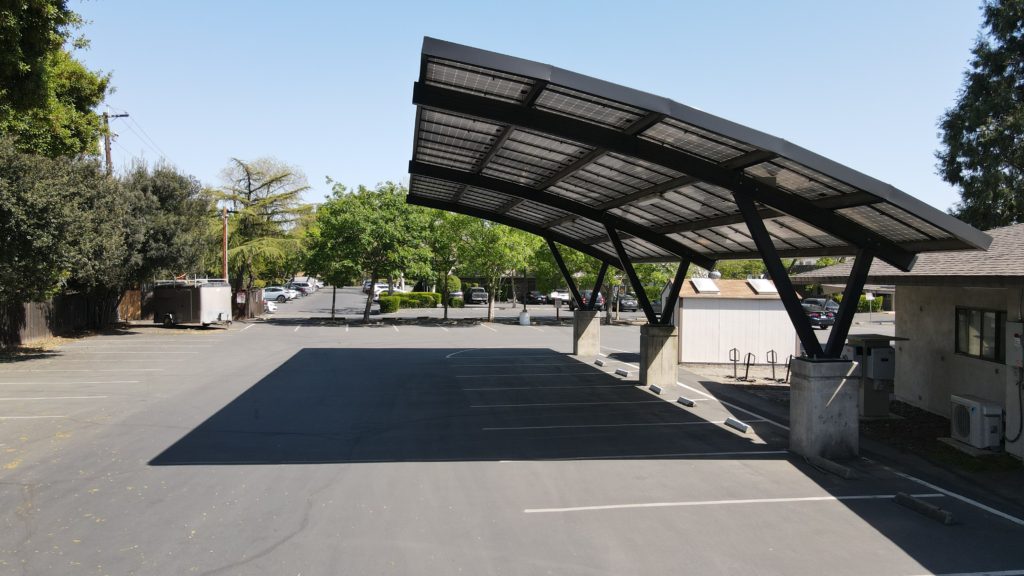
In 2004, the Episcopal Church of St. Martin in Davis, California, took first steps toward becoming a zero-carbon church by installing a small photovoltaic solar array on the roof of our administration building. That process has culminated sixteen years later with recognition by Interfaith Power and Light as a Cool Congregation with 100% carbon reduction.
Achieving this goal involved both baby steps and a few giant leaps! St. Martin’s has always been concerned about environmental sustainability. Davis’ bike-centric environment made it easy to promote bicycling to church by blessing bicycles and providing sturdy bike racks for all who use our facilities. We served as a pilot site for the City of Davis Commercial Composting program, thus diverting waste from our thrice-weekly soup kitchen and Sunday morning coffee hour out of the local landfill. A capital campaign in 2010 enabled us to replace leaky single-pane windows and outdated and inefficient lighting in the church with energy-efficient equivalents.
We took a similar approach to reducing our carbon footprint. Individual and corporate study helped us explore the connections between our faith and planetary stewardship. Parish-wide discussions, energy audits, and careful marshaling of our financial resources provided evidence that our congregation supported this work and that we could undertake it with an eye to reducing both our carbon footprint and utility bill.
Coffee hour provided opportunities to disseminate information
A parish committee – Care for God’s Creation – supported this effort, along with support from lay and clergy leaders, and congregation members at large.
We took a big step in 2013 by substantially expanding our on-site solar electricity production. We installed a large solar array through an agreement in which St. Martin’s committed to buy the clean electricity produced on its property. The array, sited over part of the parking lot, had the added benefit of providing respite from the sun’s blazing rays to the cars parked beneath it. Two years later, we swapped a lawn for a low-water meditation garden that also provides food and shelter for pollinators and birds.
In 2017, we replaced the gas-powered HVAC system in our sanctuary with a series of energy-efficient electric heat pumps that can be controlled individually, thus reducing both our energy bill and carbon use. What’s more, this experience encouraged the church to consider additional steps to achieve complete carbon reduction.
As a result, when a church member offered in late 2019 to purchase an additional 12kW of solar panels, parish leaders readily agreed. This generous gift provided enough electricity to cover not only existing electric use but also additional electric usage, as the church converted its remaining gas appliances to electric. Thus, our church effectively became solar-powered. The parishioner gained the tax credit and future depreciation, enabling him to fully gift the panels and ensuing clean electricity to the church.
In addition to the solar array that provides electricity, twelve efficient individually-controlled heat pump units now heat and cool the interior of St. Martin’s
What about the financial implications for St. Martin’s? Our outlays for HVAC electrification and solar retrofits over time, including parishioner donations, total roughly $100,000. In contrast, in 2020 alone, without on-site solar investment and purchase agreements, St. Martin’s annual energy bill would have been roughly $15,000 vs. what we actually paid: a little over $5,000. It typically takes less than a decade to pay for new systems, and savings continue to accumulate thereafter. In other words, even without the generous financial gift, the cost savings for St. Martin’s that come from going solar would have helped pay for the project by 2030.
“We face a climate crisis which will have the greatest impact on the poorest of the world. We also know we have a small and shrinking window of time to take action. Our church believed that we needed to go as far and as quickly as possible to reduce our church emissions. We hope our actions can inspire other churches, faith groups, businesses, and individuals, and our state and federal government to take the bold actions needed to care for God’s Creation.”
The Reverend Dr. Pamela L. Dolan, Rector, Episcopal Church of St. Martin
The people of St. Martin’s believe that climate change constitutes an existential threat to God’s creation and, as a result, have committed to continuing to work toward reducing our environmental footprint to create a more just and sustainable world. Throughout this process, we have encouraged parishioners to look at their own habits around transportation, dietary choices, and other lifestyle decisions that can affect greenhouse gas emissions and global change. We hope our pursuit of becoming a zero carbon church can provide individuals, other congregations, and communities with an example of what can be done, one step at a time.

